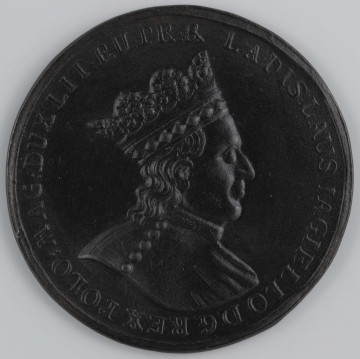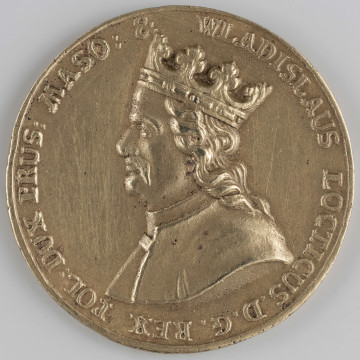
Władysław Jagiełło - Kajetan Sołtyk's entourage
1790 — 1795
National Museum in Lublin
Part of the collection: Money on Polish territory in the Middle Ages
The crown half-penny (‘półgrosz’) of King Władysław Jagiełło is the first coin of this type in the history of Polish minting, apart from the quarters of Casimir the Great. Its introduction into circulation was connected to the monetary reform of 1393. Władysław Jagiełło, after assuming the Polish throne, faced the necessity of improving the financial situation of the country, in which the improvement of the quality of minted coinage played an extremely important role. The new monetary system could be called ‘triple’, as it was based on the principle that a coin of higher value was three times the value of the coin below it. Denars had the lowest value, 3 denars made up a ternary, also called a three-cent piece, while 3 ternaries made up a half-penny.
For a long time, the role of this coin became more important than its name suggests. ‘Półgrosz’ had no competition in the form of the crown grosz. It is true that due to a stable exchange rate and a relatively stable silver content Czech grosze enjoyed popularity in Poland, but until the times of Sigismund I the Old there were no Polish coins of this type minted, and the notion of a ‘grosz’ existed only as a unit of account. Therefore, in larger transactions it was the half-penny that was the basic coin.
The iconography of Władysław Jagiełło's half-penny was not very elaborate. On the obverse, there was an image of a crown with an inscription in the rim: MONE[TA] WLADISLAI (Władysław's coin). On the reverse there was an image of a crowned eagle, and the rim contained the further part of the legend: REGIS POLONIE (King of Poland). On the obverse, under the crown, there were often letter markings. These were usually initials of the names of royal mint administrators or lessees, e.g., Piotr Bork (letter P, the first mint administrator in 1394-1395), Mikołaj Bochner (letter N = Nicolaus, administrator in 1396-1398), Andrzej Czarnysza and Szymon de Talentis (letters AS or SA, administrators in 1399-1406). The half-penny was minted in the royal mint in Kraków, however, due to the constantly deteriorating quality of the coin, the mint was closed in 1414 on the motion of the Royal Council.
The purchasing power of the half-penny was quite high. At the turn of the 14th and 15th centuries it was possible to buy about fifteen eggs for it. Two coins made it possible to buy a young rooster, and four – a hare carcass.
Leszek Poniewozik
Author / creator
Dimensions
cały obiekt:
Object type
numismatic
Technique
stamp minting
Material
silver
Creation time / dating
Creation / finding place
Owner
The National Museum in Lublin
Identification number
Location / status

1790 — 1795
National Museum in Lublin

1790 — 1810
National Museum in Lublin

1792 — 1797
National Museum in Lublin
DISCOVER this TOPIC
Museum of King Jan III's Palace at Wilanów
DISCOVER this PATH
Educational path